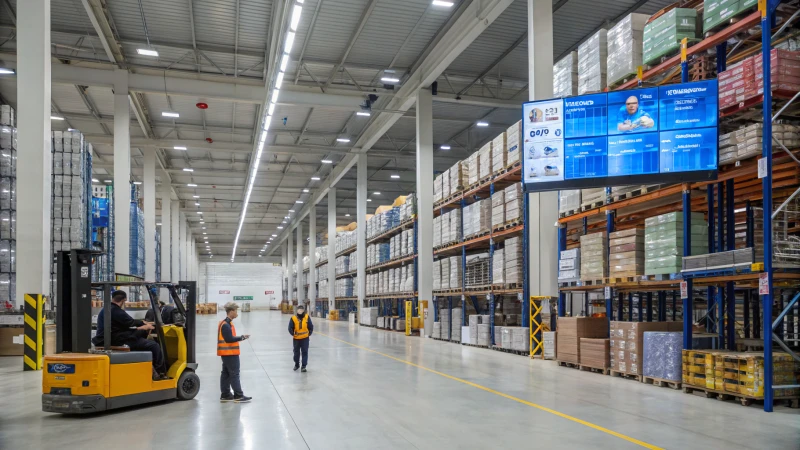
Imagine delivering happiness right to your customers’ doorsteps, no matter where they are in the world.
Multi-warehouse shipping strategies optimize logistics by cutting costs and delivery times, boosting stock availability, and reducing risks. By dispersing inventory across well-placed warehouses, businesses can heighten customer satisfaction and streamline global market operations.
Now, while this sounds like the perfect solution, implementing it is a whole different ball game. I remember the first time I considered a multi-warehouse approach. The excitement was real, but so were the challenges. It took meticulous planning and a lot of coffee-fueled nights to figure out the logistics. But, let me tell you, once it all fell into place, the payoff was incredible. Stick with me as we dive into the ins and outs of making this strategy work seamlessly for your global shipping needs.
Multi-warehouse strategies reduce shipping costs.True
Distributing inventory strategically cuts down on transportation expenses.
Multi-warehouse strategies increase delivery times.False
These strategies aim to decrease delivery times by optimizing logistics.
How Do Multi-Warehouse Strategies Reduce Shipping Costs?
Imagine cutting your shipping costs while keeping your customers happier than ever. It sounds like a dream, but it's a reality with multi-warehouse strategies.
Multi-warehouse strategies help reduce shipping costs by positioning inventory closer to customers, cutting down on transportation expenses and optimizing delivery routes. This approach boosts efficiency, shortens delivery times, and increases customer satisfaction.

Strategic Location Optimization
I remember when I first realized the power of strategic warehouse placement. It was like discovering a secret ingredient in a recipe that makes everything better. By positioning warehouses near major markets, products don't have to travel far, slashing fuel and labor costs—which can eat up a big chunk of shipping expenses. Picture this: a company with warehouses in both New York and Los Angeles. They can efficiently serve both coasts, reducing those dreaded cross-country shipping fees.
Leveraging Local Carriers
Local carriers are like the friendly neighborhood heroes of shipping. Using them for final delivery can save a ton of money because they often offer rates that national services can't match. By utilizing local networks1, companies tap into existing relationships and infrastructures, ensuring that last-mile deliveries are both cost-effective and smooth.
Inventory Management Efficiency
When I think about maintaining optimal stock levels across multiple locations, I imagine it as a game of chess. It's all about strategy and foresight—placing the right pieces in the right spots. This avoids overstocking or understocking and ensures products are ready where they're needed most. Analyzing regional demand patterns helps businesses strategically allocate inventory across warehouses, cutting down the need for expensive express shipments.
| Advantages of Multi-Warehouse Strategies |
|---|
| Reduced shipping distances |
| Lower transportation costs |
| Improved delivery times |
| Better risk management |
Risk Mitigation and Reliability
Having multiple warehouses is like having a safety net during times of crisis. It offers a buffer against regional disruptions like natural disasters or political unrest, ensuring a reliable supply chain. By spreading out inventory2, companies mitigate risks associated with relying on a single warehouse.
Enhanced Customer Experience
I can't emphasize enough how much faster deliveries and better stock availability boost customer satisfaction. In today’s fast-paced world, customers expect quick, reliable service, and multi-warehouse strategies deliver just that by slashing delivery times. This level of service often leads to increased customer loyalty3, which is priceless for business growth.
Locating warehouses near markets reduces shipping distances.True
Proximity to markets cuts fuel and labor costs by shortening delivery routes.
Using national carriers is cheaper than local carriers for delivery.False
Local carriers often offer competitive rates, reducing last-mile delivery costs.
How Does Technology Transform Multi-Warehouse Management?
Imagine juggling multiple warehouses like spinning plates—one wrong move and everything could topple. But that's where technology steps in, making it all look effortless.
Technology in multi-warehouse management boosts efficiency, fine-tunes inventory control, and cuts costs through tools like WMS, real-time tracking, and automation, ensuring smooth operations across different locations.

Optimizing Inventory with WMS
Let me tell you, managing inventory across several warehouses used to feel like I was playing a never-ending game of whack-a-mole. That's until Warehouse Management Systems (WMS) came into play. These systems are lifesavers—offering real-time data analysis and automated restocking alerts. It's like having a personal assistant who knows exactly when to remind you about refilling your pantry, only it’s for entire warehouses.
Warehouse Management Systems (WMS) are integral to efficient inventory management4. They offer capabilities such as real-time data analysis and automated restocking alerts, ensuring optimal inventory levels across all warehouses.
| Feature | Benefit |
|---|---|
| Real-time Tracking | Immediate inventory updates |
| Automated Alerts | Prevents overstock and stockouts |
Real-Time Tracking Systems
Remember the anxiety of waiting for a package without knowing its whereabouts? Real-time tracking eliminates that stress—not just for me, but for everyone involved in the supply chain. With technologies like RFID and IoT sensors, we can monitor shipments in transit like a hawk. Knowing where every item is at any given moment ensures that deliveries are not just timely but also incredibly satisfying to customers.
Real-time tracking provides unparalleled visibility into goods' movement. Technologies like RFID and IoT sensors enable monitoring shipments5 in transit, ensuring timely deliveries and better customer satisfaction.
Automation in Warehousing
Ah, automation. The word alone conjures images of robots whizzing about, making life easier. In my experience, introducing robotics and automated conveyor systems into our warehouses was like hitting fast-forward on a remote. It cut down manual labor significantly, speeding up processes like sorting and packing—especially handy when you're dealing with a surge in orders.
Automation technologies, including robotics and automated conveyor systems, reduce manual labor. This boosts operational efficiency6 by speeding up processes like sorting and packing, crucial for handling increased order volumes across multiple sites.
Data Analytics for Decision Making
If you've ever felt overwhelmed by the sheer volume of data out there, you're not alone. But using data analytics tools to sift through this information has been game-changing. These tools help me understand demand patterns, making decisions about inventory distribution and resource allocation far more informed and strategic.
Data analytics tools process vast amounts of data generated by these technologies. They provide insights into demand patterns, helping managers make informed decisions about inventory distribution7 and resource allocation.
By integrating these technologies, I’ve seen how businesses can effectively manage multi-warehouse operations. Each system enhances the others, creating a cohesive network that aligns perfectly with goals like reducing costs and boosting customer satisfaction.
WMS automates restocking alerts in warehouses.True
WMS provides automated restocking alerts to maintain optimal inventory.
RFID technology decreases warehouse efficiency.False
RFID enhances efficiency by enabling real-time tracking of goods.
How Can Businesses Mitigate Risks with Multi-Warehouse Shipping?
Navigating the complexities of multi-warehouse shipping feels like managing a mini-universe of logistics. It's a balancing act of strategy, technology, and communication, all working together to make sure everything goes smoothly.
To effectively manage risks in multi-warehouse shipping, I focus on choosing strategic warehouse locations, using advanced inventory systems, and ensuring strong communication networks. These strategies help reduce disruptions and boost efficiency.

Strategic Location Selection
Picking the right spot for each warehouse is like choosing the perfect place for a new coffee shop. It's all about knowing where the demand is hottest and placing your resources right there. I remember spending hours poring over market analysis reports8, trying to figure out where our products would be most needed. By strategically placing warehouses close to key markets, not only do I reduce delivery times and costs, but I also avoid the pitfalls of regional disruptions like unexpected storms.
| Region | Advantages | Potential Risks |
|---|---|---|
| North America | Proximity to large markets | Weather-related disruptions |
| Asia | Cost-effective labor | Political instability |
| Europe | Centralized logistics | Regulatory complexities |
Implementing Advanced Inventory Management Systems
Advanced inventory management systems are my secret weapon. They’re like having a crystal ball that forecasts demand with amazing accuracy. I used to rely on guesswork for stock levels, which sometimes led to embarrassing stockouts or costly overstocks. Now, these systems provide real-time updates, allowing me to adjust on the fly.
- Benefits:
- Real-time tracking
- Automated restocking alerts
- Data-driven decision-making
Ensuring Robust Communication Networks
You know that game where one missed message can throw everything into chaos? That's what poor communication can do to supply chains. I've found that establishing strong communication networks is crucial. Using cloud-based platforms keeps everyone in the loop, from suppliers to customers. It’s like having a group chat that never misses a beat.
Explore solutions9 that integrate seamlessly with existing systems, providing a unified communication channel.
Leveraging Technology for Risk Assessment
Incorporating AI and machine learning into risk assessment has been a game changer for me. These tools sift through data faster than I ever could, picking up patterns that might indicate future issues. It’s like having a weather forecast for my business operations.
- Example Technologies:
- Predictive analytics software
- Machine learning algorithms
- Real-time monitoring tools
Adopting these strategies has not only helped me reduce risks but also ensured my operations run smoother than ever. It's like having a playbook for winning the supply chain game.
Strategic location selection reduces delivery times.True
Placing warehouses closer to demand areas shortens delivery routes.
Advanced inventory systems increase stockouts.False
These systems optimize stock levels, reducing the risk of stockouts.
What Are the Challenges of Implementing Multi-Warehouse Strategies?
Diving into multi-warehouse strategies is like embarking on an intricate puzzle-solving adventure.
Implementing multi-warehouse strategies comes with challenges like logistics complexity, increased costs, inventory management hurdles, and technology integration issues. Overcoming these can enhance efficiency and boost customer satisfaction.

Increased Logistics Complexity
I remember when I first decided to expand our warehouse operations; it felt like playing a high-stakes game of chess. Every move needed to be strategic, especially managing logistics across multiple locations. Coordination became my new mantra. Ensuring efficient distribution networks10 was no easy feat and required advanced planning and resources.
Complexity hit hard as I juggled:
- Coordinating shipments from various places.
- Guaranteeing timely delivery for every customer.
- Managing returns and exchanges without a hitch.
Higher Operational Costs
Initially, I was drawn to the idea of slashing shipping costs. Yet, I soon realized that operating multiple warehouses could also ramp up expenses elsewhere.
| Cost Factor | Description |
|---|---|
| Staffing | Need for additional staff at each location. |
| Utilities | More facilities lead to higher utility bills. |
| Maintenance | Regular upkeep of multiple sites. |
Understanding and managing these costs became essential for achieving sustainable growth11.
Inventory Management Challenges
Keeping tabs on stock at different sites was like trying to herd cats. Robust inventory systems were a must to:
- Prevent running out of stock or overstocking.
- Keep inventory data spot-on accurate.
- Sync stock levels across all warehouses seamlessly.
Technology Integration Issues
Getting technology to play nice across multiple sites was another mountain to climb. Effective solutions had to:
- Offer real-time data access—no waiting around.
- Ensure smooth communication between systems.
- Support automation12 and decision-making at every turn.
Deploying tech that seamlessly connected all operational aspects made a world of difference in boosting overall efficiency.
Multi-warehouse strategies increase logistics complexity.True
Managing shipments and deliveries across multiple locations is complex.
Multi-warehouse strategies reduce overall operational costs.False
While shipping costs may decrease, staffing and utilities increase.
Conclusion
Multi-warehouse shipping strategies enhance global logistics by reducing costs, improving delivery times, and increasing stock availability, ultimately boosting customer satisfaction and mitigating risks in supply chains.
Discover how partnering with local carriers can lower your shipping costs by leveraging their regional expertise and infrastructure. ↩
Learn how spreading out your inventory can reduce risks and improve supply chain reliability. ↩
Explore why faster deliveries lead to increased customer satisfaction and long-term loyalty. ↩
Explore how WMS enhances inventory control, reduces errors, and improves overall warehouse efficiency. ↩
Discover the advantages of real-time tracking for monitoring shipment progress and ensuring timely delivery. ↩
Learn how automation technologies streamline warehouse operations and reduce manual labor costs. ↩
Understand how data-driven insights aid in effective inventory distribution and decision-making. ↩
Discover how to analyze market demands for optimal warehouse placement to reduce delivery times and costs. ↩
Find integrated communication solutions that enhance transparency and efficiency in supply chain operations. ↩
Learn strategies to streamline logistics coordination across multiple warehouses, enhancing delivery efficiency. ↩
Discover effective ways to control and reduce costs associated with operating multiple warehouses. ↩
Explore top technology solutions that facilitate seamless automation in multi-warehouse operations. ↩






